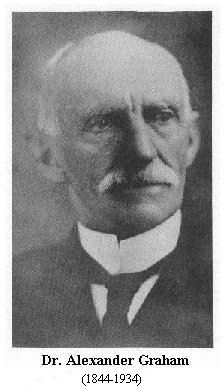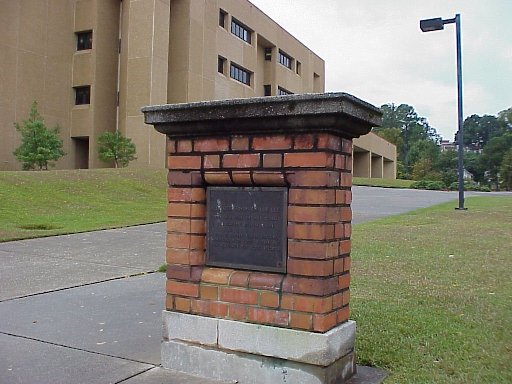Use scroll bar at right to scroll down
page

The history of Dr. Alexander Graham's ancestor is found recorded in
the files of Anna Sherman. Alexander Graham or Alestair Graeme as he was
called by the old Scottish Highlanders, was born in Knapdale, Argyleshire,
Scotland in 1745.
He enlisted in the attempt to place Charles Edward, or Prince
Charles as we speak of him, on the throne of his ancestors. Alexander
Graham was a man of some consequence in the Highlands, being a landholder and a
person of considerable influence.
After the disastrous battle of Colloden he escaped to his
native hills. Since he was one of those for whom a reward was offered he
was compelled to remain in concealment until his escape to America in
1780. The British government never relented toward him.
Alexander Graham married Mary MacCormac, also from the
Highlands of Scotland. She accompanied him to America.
In the winter of 1779, Graham found means of communication with
Capt. John Paul Jones of the American Navy, who gave him and his family
passage. The family was taken on board the vessel on the western coast of
Scotland and after nearly 100 days at sea, landed near Charleston, S.C., on
night preceding the surrender of the city to Cornwallis.
After much hardship, they finally reached the home of a
relative who had invited them to their home east of the Cape Fear River.
The relative's name was Archibald Holmes. (Descendants of Holmes in
Eastover still live on land owned by their ancestor). After a short time,
Graham bought land several miles west of Cross Creek in the Longstreet area.
On the retreat of Cornwallis from Guildford Court House, his
lordship paid visit to Alexander Graham and had the cattle belonging to Graham
killed and plundered his house as well as doing other damage.
Alexander Graham was a rigid Presbyterian, a believer in John
Knox and in a solemn league and covenant and fully believed Charles Edward
(Bonnie Prince Charles) was entitled to the British throne by all rules of
descent established in the British Kingdom.
He died September 15, 1794 and is buried beside his wife in
Longstreet cemetery.
Alexander Graham, superintendent of the Fayetteville graded
school system in 1878, was directly descended from Alexander and Mary
Graham. His father, Archibald Graham, married Ann McLeod, whose father,
Daniel McLeod, married Flora MacAlester, the daughter of Coll MacAlester and
Janet Buie. The father of Coll was Alexander MacAlester.
In 1875, Alexander Graham married Katherine Bryon Sloan,
daughter of Dr. David Dickson Sloan of Sampson County. Katherine was the
first student to register at Peace Institute (today Peace College) in 1857.
Their children were Frank Porter, George David Sloan, Archibald Wright, Neill
Ray, Mary, Harriet Dickson, Fate and Anne Alexander.
Alexander Graham was educated in the schools of Fayetteville,
probably Donaldson Academy which was organized in 1832. He became a
teacher at the age of 16 years. In 1862 he was made head of Richmond
Academy near Spring Hill. In 1864, "he joined the Confederate Army,
fought in one battle, was captured, discharged and sent back to teaching."
In1866 Alexander entered the University of North Carolina at
Chapel Hill. While in this third year, the university was forced to
close. Without a degree, he became principal of an academy in Bladen
County.
In 1871 he went to New York to teach in a grammar school on
Madison Avenue. While there, he studied law at Columbia University.
He graduated in 1873 and after passing the bar practiced law in Fayetteville
from 1875 to 1878.
Alexander Graham was "elected" (see story in History
page) superintendent of the Fayetteville Graded schools, the first of its type
in the state. In 1882 he carried two young women and one man to the
university and all passed the examination for entrance to the freshman class.
After 10 years, in 1888, Graham became superintendent of the
schools in Charlotte. A bronze plaque placed in the school named for him
was given by the children of the Charlotte schools. It states that
Alexander Graham from 1888 to 1913 was superintendent, from 1913 to 1927
assistant superintendent and from 1927 to 1934 was superintendent emeritus.
 The bronze plaques that have been placed on brick pillars taken
from the newer Alexander Graham school building are a lovely memorial to the man who
contributed so much to Fayetteville. The bronze plaques that have been placed on brick pillars taken
from the newer Alexander Graham school building are a lovely memorial to the man who
contributed so much to Fayetteville.
A state marker to his son, Frank Porter Graham, president of
the University of North Carolina 1930 to 1948, stands on Raleigh Road.
This marker was placed near the home site where he and his father was
born. The home site was known as the "Fuller Place" an in the
1930's called the "Kings Place". It no longer stands.
The above information is taken from Lucile Miller Johnson's
book, Hometown Heritage, published 1978 by Taylor Publishing
Company, Dallas, Texas in cooperation with the Colonel Robert Rowan Chapter,
National Society Daughters of the American Revolution.

|